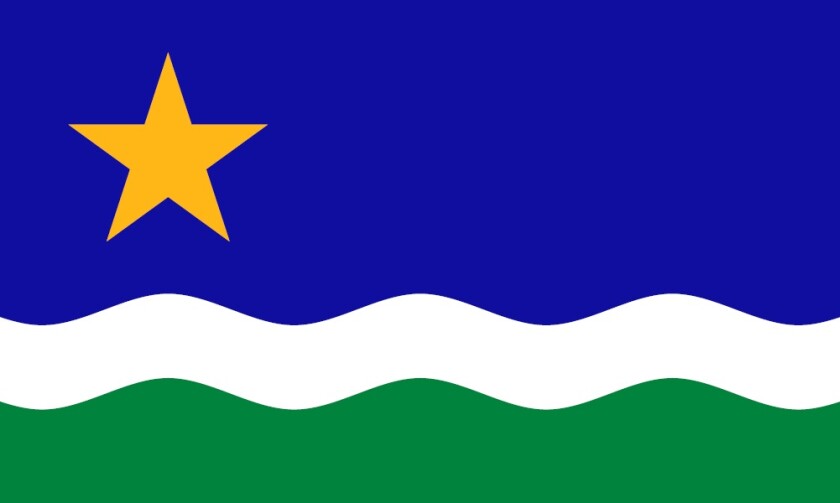ST. PAUL — Minnesota is taking another step closer to redesigning its state flag and committing its Electoral College votes to presidential candidates who win the national popular vote.
Members of the House on Tuesday approved those changes and others in a Democratic-Farmer-Labor backed $1.5 billion state government and elections package. The 182-page bill boosts spending for the state government agencies, the Legislature and government IT by $400 million in the next two-year budget. It also changes Minnesota's threshold for “major” political parties — a move that will make it harder for third parties to get on the ballot.
ADVERTISEMENT
Past that, the bill also boosts funding for the public election subsidy, something backers say will encourage more candidates to take state campaign cash and reduce the influence of special interests.
After hours of debate, the House late Tuesday night approved the bill containing the provisions on a 70-59 party-line vote. The Senate is set to take up the bill on Thursday.
Major legislative packages called “omnibus bills” are the norm at the Minnesota Capitol, where lawmakers often lump spending and other policies into big bills. The state government package contains many appropriations and polices, though there are a few highlights.
Flag and seal design
For years, critics of Minnesota’s flag have said the design is unmemorable and offensive due to its depiction of white settlers displacing Native Americans.
To redesign the flag and seal, Minnesota would create a State Emblems Redesign Commission to explore options and produce a report by Jan. 1, 2024. The commission must take public input on the new flag and can seek the service of experts to help design the flag. The state would have to adopt the new flag by May 11, 2024.
Proposed designs “must accurately and respectfully reflect Minnesota’s shared history, resources, and diverse cultural communities.” Any emblem representing a single community or person may not be included in the design.
The commission would be composed of three members appointed by the governor, as well as representatives from the Black, Latino, Asian-Pacific, Dakota and Ojibwe communities. Explore Minnesota Tourism, the Minnesota Historical Society and the Minnesota Secretary of State would also have spots on the commission.
ADVERTISEMENT
One design that could inspire the new Minnesota flag is the “North Star” flag designed by Rochester flag shop owner Lee Herold and the Rev. William Becker more than 30 years ago. Golden Valley DFL Rep. Mike Freiberg, who has long supported a redesign, wore a pin of the flag as he debated the bill Tuesday.

“Our current flag and seal can be preserved historically with adequate commentary on it, but they do not need to, and they should not remain on flag poles and official documents,” Freiberg said. “Our flag and seal are not worth keeping. They do not speak to the newer generation of Minnesotans.”
Republicans attempted to remove the flag redesign portion of the bill, with some raising concerns about a commission doing the redesign work without the Legislature’s direct involvement.
Presidential popular vote
The U.S. doesn’t elect its president by popular vote, and instead uses “electors” assigned to each state in proportion to its size, a system known as the Electoral College. When candidates win states, they typically get all the electors' votes. But sometimes, the system has resulted in presidential candidates winning even after losing the popular vote — as Donald Trump did in 2016.
Many have criticized the Electoral College for being anti-democratic, and a growing number of states, including California, New York and Illinois, have entered an agreement to give their electoral votes to the national popular vote winner. The National Popular Vote Interstate Compact would go into effect after states with the majority of electoral votes — 270 out of 538 — signed on to the agreement. Minnesota would bring the number to 205.
Republican lawmakers raised concerns on the House floor Tuesday that election laws vary greatly state-by-state and questioned whether there is truly a “national” popular vote.
Party status
Another elections-related component of the state government package is a change requiring parties to have 10% of the popular vote in a statewide election in order to be considered a major party.
ADVERTISEMENT
It’s a move Freiburg said will cut down on “electoral shenanigans." The GOP in the past has been accused of backing "spoiler" candidates to siphon votes from Democrats. Opponents, including former Gov. Jesse Ventura, who won as a third-party candidate in 1998, say it will shut out alternative voices in state politics.
While third parties have become less prominent in Minnesota politics over the last decade, the state until just recently technically had four major parties as defined by the Secretary of State, the office that administers state elections.
To be considered a major party, a party needs 5% of the vote in a statewide race, guaranteeing placement on the ballot for the next two years. The DFL, GOP, Grassroots Legal Cannabis Party and Legal Marijuana Now all enjoyed that status in the last election, though Grassroots failed to meet the threshold in 2022 and lost its status.
What’s next?
Democratic-Farmer-Labor lawmakers have made changing state election laws a priority during this session. In March, Gov. Tim Walz signed into law a bill restoring voting rights to felons on probation. Last week, the House approved another elections bill that would create automatic voter registration and penalties for election misinformation.
The DFL-led Minnesota Senate is set to take up the $1.5 billion House state government package Thursday. It’s just one part of an overall budget Democrats are pushing for that will add $17.9 billion of spending on top of the over $50 billion two-year state budget.
Follow Alex Derosier on Twitter or email aderosier@forumcomm.com .
The story was updated with the result of the vote at 10:35 p.m. on April 18. It was originally posted at 7:02 p.m.
ADVERTISEMENT


















